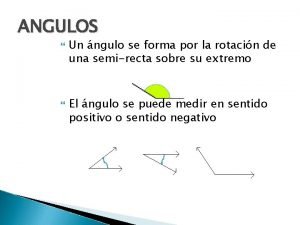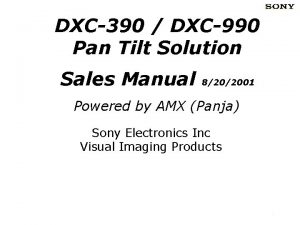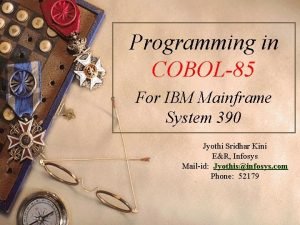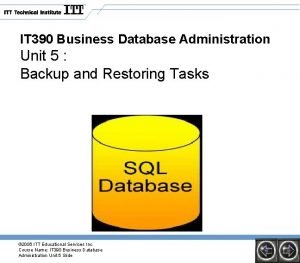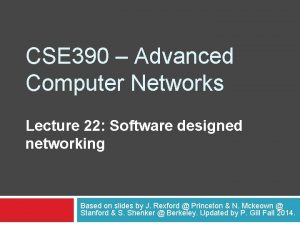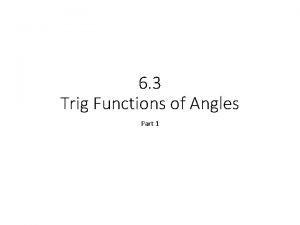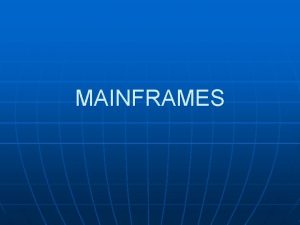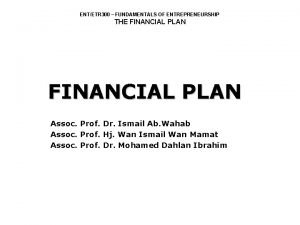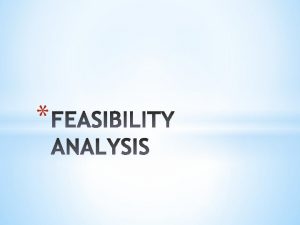Entrepreneurship for Computer Science CS 15 390 Financial



























- Slides: 27

Entrepreneurship for Computer Science CS 15 -390 Financial Accounting- Part III Lecture 19, April 1, 2018 Mohammad Hammoud

Today… • Last Session: • A lecture on communications by Kit Needham- Part II • Today’s Session: • Financial Accounting- Part III • Announcements: • CP 3 is due on April 14. All teams will present their works in the last week of classes (i. e. , in April 15 and April 17) • Quiz II will be held next Sunday, April 8 (all the materials covered after the midterm are included)

Interpreting Balance Sheets: An Example ASSETS LIABILITIES Current Assets Current Liabilities Cash $5, 000 Assets that are. Accounts easily. Receivable converted into cash within. Inventory the next operating Totalwithin Current Assets period (typically 1 year) $10, 000 $100, 000 $115, 000 Long-Term (Noncurrent) Assets Wages Payablethat have Short-term obligations Taxes Payable 1 year to be paid within Total Current Liabilities $80, 000 $5, 000 $2, 000 $87, 000 Long-Term (Noncurrent Debts) Equipment $30, 000 Accumulated Depreciation ($3, 000) Assets that CANNOT be easily converted Net Long-Term Assets $27, 000 into cash within the next operating period (typically within 1 year) Total Assets Accounts Payable $142, 000 Bank Debt Long-term obligations that will be Liabilities paid off. Total over a period of years $10, 000 $97, 000 OWNER’S EQUITY Common Stock $15, 000 Retained Earnings $30, 000 Total Owner’s Equity $45, 000 Total Liabilities & Owner’s Equity $142, 000

Interpreting Balance Sheets: An Example ASSETS Current Assets - LIABILITIES Current Liabilities = Net Working Capital Cash $5, 000 Accounts Payable Accounts Receivable $10, 000 Wages Payable $5, 000 Inventory $100, 000 Taxes Payable $2, 000 Total Current Assets $115, 000 Total Current Liabilities Long-Term (Noncurrent) Assets $80, 000 A $87, 000 measure of solvency Long-Term (Noncurrent Debts) Equipment $30, 000 Accumulated Depreciation ($3, 000) Net Long-Term Assets $27, 000 Bank Debt $10, 000 Total Liabilities $97, 000 OWNER’S EQUITY Total Assets $142, 000 Common Stock $15, 000 Retained Earnings $30, 000 Total Owner’s Equity $45, 000 Total Liabilities & Owner’s Equity $142, 000

Interpreting Balance Sheets: An Example ASSETS LIABILITIES Current Assets Current Liabilities Cash $5, 000 Accounts Payable $80, 000 Accounts Receivable $10, 000 Wages Payable $5, 000 Inventory $100, 000 Taxes Payable $2, 000 Total Current Assets $115, 000 Total Current Liabilities $87, 000 Long-Term (Noncurrent) Assets Equipment Listed in the Accumulated Depreciation Net Long-Term Assets order of liquidity (i. e. , the ability of an asset to be converted into cash) Total Assets Long-Term (Noncurrent Debts) $30, 000 Bank Debt $10, 000 Total Liabilities $97, 000 ($3, 000) $27, 000 OWNER’S EQUITY $142, 000 Common Stock $15, 000 Retained Earnings $30, 000 Total Owner’s Equity $45, 000 Total Liabilities & Owner’s Equity $142, 000

Interpreting Balance Sheets: An Example ASSETS LIABILITIES Current Assets Current Liabilities Cash $5, 000 Accounts Payable $80, 000 Accounts Receivable $10, 000 Wages Payable $5, 000 Inventory $100, 000 Taxes Payable $2, 000 Total Current Assets $115, 000 Total Current Liabilities $87, 000 Long-Term (Noncurrent) Assets Long-Term (Noncurrent Debts) Equipment $30, 000 Accumulated Depreciation ($3, 000) Net Long-Term Assets $27, 000 Bank Debt $10, 000 Total Liabilities $97, 000 OWNER’S EQUITY Total Assets $142, 000 Common Stock $15, 000 Retained Earnings $30, 000 Total Owner’s Equity $45, 000 Total Liabilities & Owner’s Equity $142, 000

Interpreting Balance Sheets: An Example ASSETS LIABILITIES Current Assets Current Liabilities Cash $5, 000 Accounts Payable $80, 000 Accounts Receivable $10, 000 Wages Payable $5, 000 Inventory $100, 000 Taxes Payable $2, 000 Total Current Assets $115, 000 Total Current Liabilities $87, 000 Long-Term (Noncurrent) Assets Long-Term (Noncurrent Debts) Equipment $30, 000 Accumulated Depreciation ($3, 000) Net Long-Term Assets $27, 000 Bank Debt $10, 000 Total Liabilities $97, 000 OWNER’S EQUITY Total Assets $142, 000 Common Stock $15, 000 Retained Earnings $30, 000 Total Owner’s Equity $45, 000 Total Liabilities & Owner’s Equity $142, 000

Interpreting Balance Sheets: An Example ASSETS LIABILITIES Current Assets Current Liabilities Cash $5, 000 Accounts Payable $80, 000 Accounts Receivable $10, 000 Wages Payable $5, 000 Inventory $100, 000 Taxes Payable $2, 000 Total Current Assets $115, 000 Total Current Liabilities $87, 000 Long-Term (Noncurrent) Assets Long-Term (Noncurrent Debts) Equipment $30, 000 Accumulated Depreciation ($3, 000) Net Long-Term Assets $27, 000 Bank Debt $10, 000 Total Liabilities $97, 000 OWNER’S EQUITY Total Assets $142, 000 Common Stock $15, 000 Retained Earnings $30, 000 Total Owner’s Equity $45, 000 Total Liabilities & Owner’s Equity $142, 000

Interpreting Balance Sheets: An Example ASSETS LIABILITIES Current Assets Current Liabilities Cash $5, 000 Accounts Payable $80, 000 Accounts Receivable $10, 000 Wages Payable $5, 000 Inventory $100, 000 Taxes Payable $2, 000 Total Current Assets $115, 000 Total Current Liabilities $87, 000 Long-Term (Noncurrent) Assets Long-Term (Noncurrent Debts) Equipment $30, 000 Accumulated Depreciation ($3, 000) Net Long-Term Assets $27, 000 Bank Debt $10, 000 Total Liabilities $97, 000 OWNER’S EQUITY Total Assets $142, 000 Common Stock $15, 000 Retained Earnings $30, 000 Total Owner’s Equity $45, 000 Total Liabilities & Owner’s Equity $142, 000

Interpreting Balance Sheets: An Example ASSETS LIABILITIES Current Assets Current Liabilities Cash $5, 000 Accounts Payable $80, 000 Accounts Receivable $10, 000 Wages Payable $5, 000 Inventory $100, 000 Taxes Payable $2, 000 Total Current Assets $115, 000 Total Current Liabilities $87, 000 Long-Term (Noncurrent) Assets Long-Term (Noncurrent Debts) Equipment $30, 000 Accumulated Depreciation ($3, 000) Net Long-Term Assets $27, 000 Bank Debt $10, 000 Total Liabilities Listed in the $97, 000 order that they are due OWNER’S EQUITY Total Assets $142, 000 Common Stock $15, 000 Retained Earnings $30, 000 Total Owner’s Equity $45, 000 Total Liabilities & Owner’s Equity $142, 000

Interpreting Balance Sheets: An Example ASSETS LIABILITIES Current Assets Current Liabilities Cash $5, 000 Accounts Payable $80, 000 Accounts Receivable $10, 000 Wages Payable $5, 000 Inventory $100, 000 Taxes Payable $2, 000 Total Current Assets $115, 000 Total Current Liabilities $87, 000 Long-Term (Noncurrent) Assets Long-Term (Noncurrent Debts) Equipment $30, 000 Accumulated Depreciation ($3, 000) Net Long-Term Assets $27, 000 Bank Debt $10, 000 Total Liabilities $97, 000 OWNER’S EQUITY Total Assets $142, 000 Common Stock $15, 000 Retained Earnings $30, 000 Total Owner’s Equity $45, 000 Total Liabilities & Owner’s Equity $142, 000

Interpreting Balance Sheets: An Example ASSETS LIABILITIES Current Assets Current Liabilities Cash $5, 000 Accounts Payable $80, 000 Accounts Receivable $10, 000 Wages Payable $5, 000 Inventory $100, 000 Taxes Payable $2, 000 Total Current Assets $115, 000 Total Current Liabilities $87, 000 Long-Term (Noncurrent) Assets Long-Term (Noncurrent Debts) Equipment $30, 000 Accumulated Depreciation ($3, 000) Net Long-Term Assets $27, 000 Bank Debt $10, 000 Total Liabilities $97, 000 OWNER’S EQUITY Total Assets $142, 000 Common Stock $15, 000 Retained Earnings $30, 000 Total Owner’s Equity $45, 000 Total Liabilities & Owner’s Equity $142, 000

Interpreting Balance Sheets: An Example ASSETS LIABILITIES Current Assets Current Liabilities Cash $5, 000 Accounts Payable $80, 000 Accounts Receivable $10, 000 Wages Payable $5, 000 Inventory $100, 000 Taxes Payable $2, 000 Total Current Assets $115, 000 Total Current Liabilities $87, 000 Long-Term (Noncurrent) Assets Long-Term (Noncurrent Debts) Equipment $30, 000 Accumulated Depreciation ($3, 000) Net Long-Term Assets $27, 000 Bank Debt $10, 000 Total Liabilities $97, 000 OWNER’S EQUITY Total Assets $142, 000 Common Stock $15, 000 Retained Earnings $30, 000 Total Owner’s Equity $45, 000 Total Liabilities & Owner’s Equity $142, 000

Interpreting Balance Sheets: An Example ASSETS LIABILITIES Current Assets Current Liabilities Cash $5, 000 Accounts Payable $80, 000 Accounts Receivable $10, 000 Wages Payable $5, 000 Inventory $100, 000 Taxes Payable $2, 000 Total Current Assets $115, 000 Total Current Liabilities $87, 000 Long-Term (Noncurrent) Assets Long-Term (Noncurrent Debts) Equipment $30, 000 Accumulated Depreciation ($3, 000) Net Long-Term Assets $27, 000 Bank Debt $10, 000 Total Liabilities $97, 000 OWNER’S EQUITY Total Assets $142, 000 Common Stock $15, 000 Retained Earnings $30, 000 Total Owner’s Equity $45, 000 Total Liabilities & Owner’s Equity $142, 000

Interpreting Balance Sheets: An Example ASSETS LIABILITIES Current Assets Current Liabilities Cash $5, 000 Accounts Payable $80, 000 Accounts Receivable $10, 000 Wages Payable $5, 000 Inventory $100, 000 Taxes Payable $2, 000 Total Current Assets $115, 000 Total Current Liabilities $87, 000 Long-Term (Noncurrent) Assets Long-Term (Noncurrent Debts) Equipment $30, 000 Accumulated Depreciation ($3, 000) Net Long-Term Assets $27, 000 Bank Debt $10, 000 Total Liabilities $97, 000 OWNER’S EQUITY Total Assets $142, 000 Common Stock $15, 000 Retained Earnings $30, 000 Total Owner’s Equity $45, 000 Total Liabilities & Owner’s Equity $142, 000

Interpreting Balance Sheets: An Example ASSETS LIABILITIES Current Assets Current Liabilities Cash $5, 000 Accounts Payable $80, 000 Accounts Receivable $10, 000 Wages Payable $5, 000 Inventory $100, 000 Taxes Payable $2, 000 Total Current Assets $115, 000 Total Current Liabilities $87, 000 Long-Term (Noncurrent) Assets Long-Term (Noncurrent Debts) Equipment $30, 000 Accumulated Depreciation ($3, 000) Net Long-Term Assets $27, 000 Bank Debt $10, 000 Total Liabilities $97, 000 OWNER’S EQUITY Total Assets $142, 000 Common Stock $15, 000 Retained Earnings $30, 000 Total Owner’s Equity $45, 000 Total Liabilities & Owner’s Equity $142, 000 Let us elaborate a little bit on this section

Stocks: Few Basics • A stock is a piece of ownership in a company • A holder of stocks (i. e. , a shareholder) has a claim to a part of the company's assets and earnings • The ownership of a shareholder is determined by the number of shares they own relative to the number of outstanding shares • E. g. , If a company has 1, 000 outstanding shares and one person owns 100 shares, that person would own and have claim to 10% of the company's assets and earnings • Outstanding shares include shares held by institutional investors as well as restricted shares held by insiders and company officers

Stocks: Few Basics • There are two types of stocks: 1. Common Stocks: • They entitle the owners to vote at meetings of board of directors • The owners may or may not receive dividends (i. e. , a distribution of a portion of a company’s earnings), decided by the board of directors 2. Preferred Stocks: • They do not entitle the owners to vote at meetings of board of directors • The owners receive fixed periodic dividends • They are cumulative; that is, if a payment to an owner is skipped due to insufficient earnings, it should be paid when earnings allow • They have a higher claim on assets and earnings than common stocks • E. g. , Owners of preferred stocks receive dividends before common shareholders and are given priority in the events of bankruptcy and liquidation

Stocks: Few Basics • On many balance sheets, common stock is divided into 2 components: 1. Common Stock at Par Value • Par value is an arbitrary value that represents the cost of a share; it is set when the company originally issues shares before there is a market • Most companies set a par value for their stocks to a minimal amount • E. g. , The par value for shares of Apple is $0. 00001 and the par value for Amazon stock is $0. 01 • Shares cannot be sold below par value upon Initial Public Offering (IPO)- this way, investors are confident that no one will receive a favorable price treatment (more on IPOs next week) 2. Additional Paid-in Capital (or Capital Surplus) • This represents the excess paid by an investor over and above the share’s par value

Example: X Inc. • $10, 000 of common stock at $0. 50 per share entails 10, 000/0. 5 = 20, 000 shares of stock outstanding X Inc. Equity Section of Balance Sheet For the Year Ending December 31, 2017 Common Stock ($0. 50 par value) Additional paid-in capital Retained Earnings $10, 000 $44, 000 $32, 000 Total Shareholders Equity $86, 000 • The total amount of money raised by X Inc. from the sale of all of its stock through time has been: • Common stock at par + Additional paid-in capital = $10, 000 + $44, 000 = $54, 000 • This amount represents an average value of $2. 70 per share

Retained Earnings • Retained earnings on a balance sheet are equal to the prior year’s retained earnings plus this year’s addition to retained earnings • Assume for X Inc. : • Net income = $12, 000 • Common stock dividends paid = $3, 000 • Thus, the addition to retained earnings = $12, 000 - $3, 000 = $9, 000 X Inc. Equity Section of Balance Sheet For the Year Ending December 31, 2017 Common Stock ($0. 50 par value) Additional paid-in capital Retained Earnings $10, 000 $44, 000 $32, 000 Total Shareholders Equity $86, 000 • What was the retained earnings on the balance sheet of X Inc. for the year ending December 31, 2016? 32, 000 - $9, 000 = $23, 000

Retained Earnings: A Common Error • A common error concerning retained earnings is that the amount listed on a balance sheet for a given year can be used by the respective company to cover future losses or pay off debt • Retained earnings are NOT cash! • Rather, retained earnings are money that have been used over years to purchase assets • They cannot be “re-spent” unless the company wants to liquidate assets previously purchased

Book Value vs. Market Value • The sum of common stock at par value, additional paid-in capital, and retained earnings of a company signifies its book value • What is the book value of X Inc. ? • $86, 000 • If X Inc. trades in the stock market at a current price per share of $6. 00, then its equity would be: X Inc. Equity Section of Balance Sheet For the Year Ending December 31, 2017 Common Stock ($0. 50 par value) Additional paid-in capital Retained Earnings $10, 000 $44, 000 $32, 000 Total Shareholders Equity $86, 000 • 20, 000 shares × $6. 00 per share = $120, 000 • This is referred to as the market value of X Inc.

Valuating Post-Revenue Companies • There is nearly always a disparity between the book value and the market value of a company (or of an asset in a company) • The book value is a recorded historical cost (or original acquisition cost) • The market value is based on the perceived supply and demand, which can vary constantly • This disparity shall be recognized at the point of sale • Prior to sale, there is no reason to account for any differences! • A company’s valuation can be specified at its market value, but if the difference between book and market values is considerable, an appraisal process must be used to reconcile them

Valuating Pre-Revenue Companies • How can you valuate your pre-revenue startup? • Use your business model to develop a corresponding mathematical model • Select your beachhead market using the process we learned earlier in the term • Use your mathematical model to do projections for your beachhead market over 5 or 7 years (assume very conservative parameter values) • Compute the net present value of your projections • The riskier and earlier your startup, the higher the discount rate should be (a discount rate between 40% and 70% is not uncommon) • What are the factors that can play roles in reducing the discount rate (and accordingly, increase the valuation of your startup)?

Valuating Pre-Revenue Companies • Some factors that can play roles in reducing the discount rate: • “Who is the team? ” • “How solid are your market research and business model? ” • “Do you have a strong IP or patent”? • “At which development stage is your product currently”? • “Do you have any letters-of-intent and/or binding contracts”? • “Have you started experimenting & have you collected any promising statistics that can verify your value and growth hypotheses”? • “Do you have a clear plan and a solid strategy to cross the chasm”?

Next Class • Financial Accounting- Part IV
 Entrepreneurship module 1 introduction to entrepreneurship
Entrepreneurship module 1 introduction to entrepreneurship Eosint p 390
Eosint p 390 Cse 390
Cse 390 Seno coseno tangente cotangente secante cosecante
Seno coseno tangente cotangente secante cosecante Ogle-2005-blg-390
Ogle-2005-blg-390 Sony dxc 390
Sony dxc 390 900 en yakın onluğa yuvarlama
900 en yakın onluğa yuvarlama Ece 390
Ece 390 Sec 390
Sec 390 Cobol area a and area b
Cobol area a and area b It 390
It 390 Cse 390
Cse 390 Terminal side of theta
Terminal side of theta Cse 390
Cse 390 Ee-390
Ee-390 Os/390
Os/390 Pe is my favourite subject
Pe is my favourite subject Entetr
Entetr Personality feasibility
Personality feasibility Fspos vägledning för kontinuitetshantering
Fspos vägledning för kontinuitetshantering Typiska drag för en novell
Typiska drag för en novell Tack för att ni lyssnade bild
Tack för att ni lyssnade bild Ekologiskt fotavtryck
Ekologiskt fotavtryck Varför kallas perioden 1918-1939 för mellankrigstiden
Varför kallas perioden 1918-1939 för mellankrigstiden En lathund för arbete med kontinuitetshantering
En lathund för arbete med kontinuitetshantering Underlag för särskild löneskatt på pensionskostnader
Underlag för särskild löneskatt på pensionskostnader Tidbok för yrkesförare
Tidbok för yrkesförare Sura för anatom
Sura för anatom



